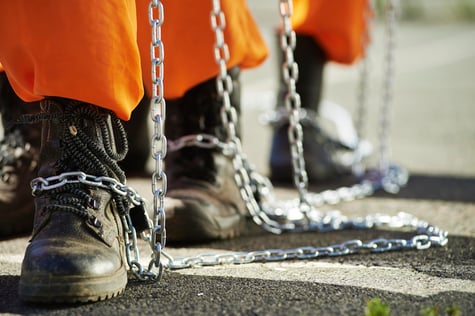
There are 2.7 million children with a parent in prison or jail. Ninety-two percent (92%) of parents in prison are fathers.
The sort-of good news is that ninety-five (95%) of all inmates will eventually be released. The not-so-good news is that most—2 out of 3 inmates—will re-offend and be back in prison.
It's clear we have a problem. But we also have a solution.
When we talk about father absence in general, we focus on the U.S. Census Bureau's statistic that 24 million children—one out of three—live without their dad in the home. Consequently, there is a “father factor” in nearly all of the societal issues facing America today.
We must take action to raise up more involved, responsible, and committed fathers. And that includes fathers who are currently (or formerly) incarcerated.
To help you better understand and share this message, we created a simple yet powerful infographic outlining the problem and solution for America's children due to fathers behind bars.
The Facts [The Problem for America's Children]
- There are 2.7 million children with a parent in prison or jail.

- Ninety-two percent (92%) of parents in prison are fathers.
- The number of children with a father in prison has grown by 79% since 1991.
- Having a parent who is incarcerated is now recognized as an “adverse childhood experience” (ACE). This is different from other ACEs because of the trauma, stigma, and shame it inflicts on children.
- More than 650,000 ex-offenders are released from prison every year. Fathers are returning to their children and families without the skills they need to be involved, responsible, and committed fathers.
- Incarceration often spans generations. Fathers in prison are, overwhelmingly, fatherless themselves. Youths in father-absent households have significantly higher odds of incarceration.
- Two-thirds of released prisoners, or 429,000, are likely to be rearrested within three years. Recidivism is a huge, national problem, and fathers are leaving their children behind.
The Solution for America's Children
- Give incarcerated fathers a vision that they have a unique and irreplaceable role in the life of their child. Increased confidence, along with changes in attitude and skills are a powerful motivator for successful reentry and to bring home fathers to their children.
- Use an evidence-based program to rehabilitate fathers and train men on what it means to be a man and a father. NFI's InsideOut Dad® program is the only evidence-based parenting program designed specifically for incarcerated fathers. An evaluation conducted by Rutger's University found that fathers who went through InsideOut Dad® while in prison showed statistically significant increases in fathering knowledge and confidence/self-esteem compared to a control group.
- Connect fathers with their children heart-to-heart. Through activities and group sessions in a program like InsideOut Dad®, fathers take action to reach out to their children to begin, repair, or rejuvenate relationships with their children and families.
- Help to reduce recidivism, especially for fathers. Fathers who are involved with, and connected to their children and families prior to release are less likely to return to jail or prison. In fact, some states have conducted evaluations that connect the use of NFI's InsideOut Dad® program along with other interventions to reduce recidivism.
Further, the InsideOut Dad® fatherhood program addresses criminogenic needs, a key factor in:
- Maintaining Facility Safety and Order: Fatherhood Programs connect inmates to their role as a man, and specifically as a father, which in turn, helps to create a peaceful, contented environment as much as possible. In addition, men who participate in fatherhood groups often create a bond among members, which generates good morale. Good morale is important for safety and there are less disciplinary infractions.
- The marital/family domain that is concerned with an offender's family relationships: A study by the Vera Institute of Justice found the strongest predictor of success upon reentry was the perception by the person released that he/she had family support.
It's time for a solution that's cost effective for taxpayers and facilities: Give incarcerated fathers the training they need to connect with their families and children prior to release.
Be a Part of The Solution.
Partner with or volunteer in your local jail or prison to offer InsideOut® Dad program to the inmates.
It costs an average of $29,000 per year to incarcerate a parent. The InsideOut Dad® program costs $600 for the first 10 fathers, then sustained at only $10 per father.
Visit Fatherhood.org/iod to download a sample of InsideOut Dad® or visit our InsideOut Dad® Page.
Click here to enlarge the infographic below.
![Fathers Behind Bars: The Problem & Solution for America's Children [Infographic] Fathers Behind Bars: The Problem & Solution for America's Children [Infographic]](https://www.fatherhood.org/hs-fs/hub/135704/file-1749208630.jpg?width=600&name=file-1749208630.jpg)
Share this Image On Your Site
Download a sample of our popular InsideOut Dad® resource or visit our InsideOut Dad® Page to learn how you can connect an incarcerated father to his child.

![Fathers Behind Bars: The Problem & Solution for America's Children [Infographic] Fathers Behind Bars: The Problem & Solution for America's Children [Infographic]](https://www.fatherhood.org/hs-fs/hub/135704/file-1749208630.jpg?width=600&name=file-1749208630.jpg)
